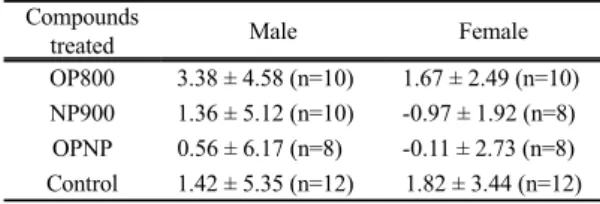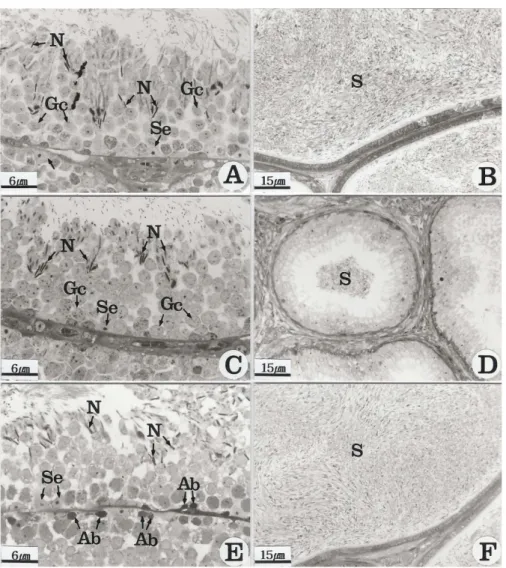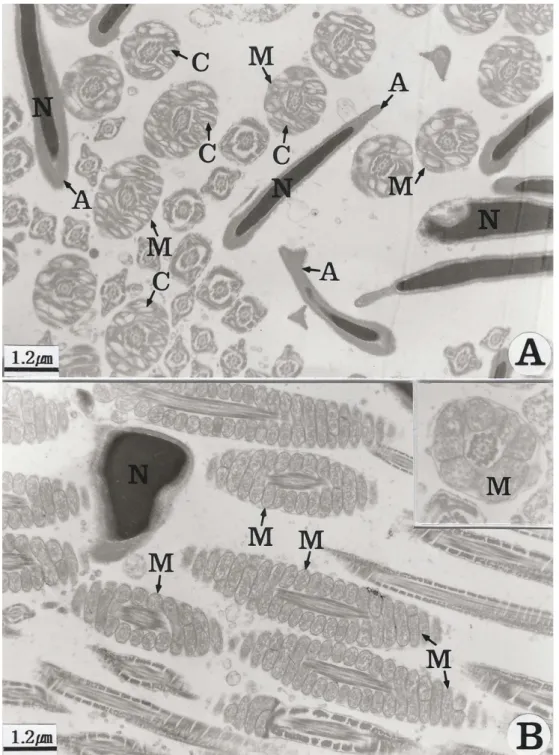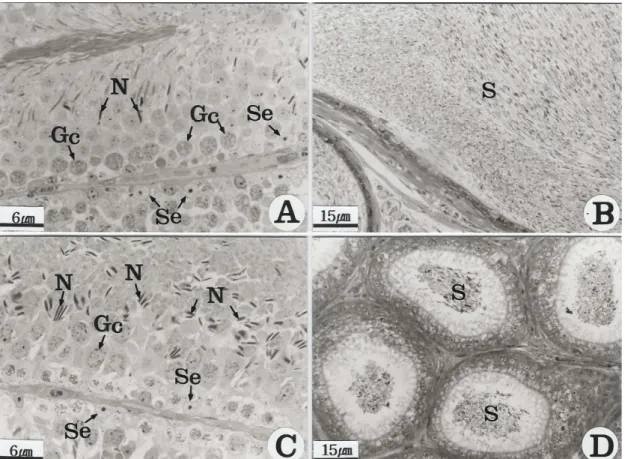ORIGINAL ARTICLE
4-t-octylphenol과 nonylphenol이 등줄쥐의 번식에 미치는 영향
김지혜․윤명희*
경성대학교 생물학과
Effects of 4-t-octylphenol and Nonylphenol on the Reproduction of the Striped Field Mouse
Ji-Hye Kim, Myung-Hee Yoon*
Department of Biology, Kyungsung University, Busan 608-736, Korea
Abstract
To investigate the effects of octylphenol and nonylphenol on the reproduction of the striped field mouse, the mice were subcutaneousely injected with 4-t-octylphenol 800 mg/kg (OP800), nonylphenol 900 mg/kg (NP900) or OP800 + NP900 (OPNP), respectively, in two times a week for 2 months. As the results, there were no differences between the control and the compound-treated groups in the body weight in both sexes, and the GSI (gonadosomatic index) and SVI (seminal vesicles index) in the adult males. But histological abnormalities of the reproductive organs in the mice seems to be related to the compound. This suggestion is supported by the facts that most mice treated with the compounds had only a small number of spermatozoa in the shrunken epididymal tubules. In addition, the shrunken reproductive organ in one mouse treated with the NP, suggests that the abnormalities in the wild striped field mice might be induced by the compound. Furthermore, it is indicated that the compounds must be toxicants to inhibit pregnancy, judging from the fact that all the mice treated with the compounds had failed to deliver.
Key words : 4-t-octylphenol, Nonylphenol, Reproduction, GSI, Striped field mouse
1. 서 론1)
내분비계장애물질로 알려져 있는 페놀화합물 중 알킬페놀류인 octylphenol과 nonylphenol은 가정용 및 공업용 세제 등의 계면활성제, 살충제 등에 포함되 는 액화 중합제 및 샴푸나 화장품 등에 첨가되는 윤활 제 등으로 사용되고 있다(Colborn 등, 1996). 이들 화 합물은 공업용 및 가정용 오ㆍ폐수의 형태로 강과 하 천 등을 오염시켜 먹이 연쇄를 통해 상위 소비자에게 까지 영향을 미친다고 알려져 있는데(Colborn 등,
1996; Hossaini 등, 2001; Sheahan 등, 2002), 어류에 서의 imposex 현상과 개체 수 감소 현상이 보고되어 있으며(Colborn 등, 1996), 무지개 송어에서는 유출수 내에 포함된 nonylphenol, mono-, di-ethoxylates에 의 해서 정소발육 지연현상이 발생한다고 알려져 있다 (Shean 등, 2002). 또한 octylphenol을 투여한 흰쥐에 서 정소, 부정소 및 전립선의 무게 감소와 정자수 감소 및 운동능력 저하 등이 관찰되고(Qian 등, 2006), nonylphenol을 투여한 흰쥐에서 정소의 조직학적 변 화 및 정자형성과정에 이상이 나타난다고 알려진 바
Received 12 December, 2013; Revised 21 January, 2014;
Accepted 6 February, 2014
*Corresponding author : Myung-Hee Yoon, Department of Biology, Kyungsung University, Busan 608-736, Korea
Phone: +82-51-663-4642 E-mail: yhyun@ks.ac.kr
ⓒ The Korean Environmental Sciences Society. All rights reserved.
This is an Open-Access article distributed under the terms of the Creative Commons Attribution Non-Commercial License (http://
creativecommons.org/licenses/by-nc/3.0) which permits unrestricted non-commercial use, distribution, and reproduction in any medium, provided the original work is properly cited.
있다(Benjamin 등, 2003).
본 연구자들은 부산광역시 가덕도 대항동, 남해군 삼동면 및 산청군 지리산에서 포획한 일부 등줄쥐에서 높은 농도의 페놀화합물(4-t-octylphenol, nonylphenol 및 BPA)과 유기주석화합물(monobutyltin, MBT;
dibutyltin, DBT; tributyltin, TBT)을 검출하였으며, 이들 등줄쥐의 대부분에서 생식소중량지수(GSI) 및 정소나 부정소 조직에 이상이 관찰된 점으로부터, 등 줄쥐의 번식 이상이 이들 화합물의 영향에 의한 것이 라고 추론한 바 있다(Kim 등, 2006). 즉 이들 화합물에 의한 어류(Shean 등, 2002)나 흰쥐(Han 등, 2004; Qian 등, 2006)의 생식소 이상 현상으로부터 야생 등줄쥐에 서 나타난 번식 이상이 이들 화합물질에 의한 내분비 계 교란현상일 가능성을 제시한 것이다. 그러나, 이들 화합물이 야생 동물에 미치는 실질적 영향은 그 동물 을 이용한 투여 실험을 통해서 입증될 수 있을 것이다. 따라서 본 연구에서는 위 연구에서 검출된 화합물 중 4-t-octylphenol 및 nonylphenol을 야생 등줄쥐에 투여하여, 이들 화합물이 등줄쥐의 생식기관에 미치 는 영향 및 다음 세대의 출생과 번식에 미치는 영향에 대하여 알아 봄으로써, 야생 등줄쥐에서 나타나는 생 식소 이상 현상(Kim 등, 2006)이 실지로 이들 화합물 에 의한 것인지를 검증하고자 하였다.
2. 재료 및 방법
2.1. 등줄쥐 채집
본 연구를 위하여 부산시 황령산과 대저동 및 양산 시 상북면 지역에서 각각 한달 간 등줄쥐를 포획하여, 이 중 생식소 및 번식에 이상이 없음이 확인된 양산시 상북면 산저지대 초원지역을 포획지로 선정하였다. 포획한 모든 수컷 등줄쥐의 생식소는 외견상 잘 발달 되어 있었으며, 등줄쥐 중 20 g 이상의 성체 암ㆍ수 40 쌍을 4-t-octylphenol과 nonylphenol의 투여실험에 이 용하였다. 각 등줄쥐들은 포획 직후, 실험실로 옮겨와 서 일주일간 순화시키고, 투여 실험 동안 암ㆍ수 한 쌍 씩 사육용 케이지에 넣어 야생 상태와 유사한 온도 및 일조 환경의 조성을 위해 실외에서 사육하였다. 사육 용 사료와 물은 충분히 공급하였으며, 신선한 야채와 과일 등을 수시로 공급하여 스트레스를 최소화하였
다. 본 실험은 농림수산검역본부에서 고시한 동물용 의약품 등 독성시험지침을 참고하였으며, 등줄쥐 의 사육은 등줄쥐의 야생성을 고려하여 Oh와 Mori (1998)의 방법을 참고로 하였다.
2.2. 4-t-octylphenol과 nonylphenol의 투여
Octylphenol은 앞서 설명한 바와 같이 내분비계 장 애물질로서 호흡계를 자극하는 물질로 알려져 있으 며, rat에 경구 투여 시 LD50값은 4600 mg/kg으로 보 고되어 있다(Scholar Chemistry, 2008). Nonylphenol 도 내분비계 장애물질로서 생식 독소로 작용하는 물질 이다. Rat의 경우 LD50값은 960-3980 mg/kg, LC50은 1150 mg/kg으로 알려져 있다(Megaloid laboratories, 2010).본 연구에 사용된 4-t-octylphenol (OP, (C8H17) C6H4OH, MW=206.32) 과 nonylphenol (NP, C15H24O, MW=220.35)은 Aldrich 사에서 구입한 것으로서, 이 들을 corn oil (Sigma사)에 녹여 사용하였다. 암ㆍ수 각각 10쌍씩에게 4-t-octylphenol 800 mg/kg/day (OP800)또는 nonylphenol 900 mg/kg/day (NP900) 을, 다른 암ㆍ수 각각 8쌍씩에게 4-t-octylphenol 800 mg/kg/day 과 nonylphenol 900 mg/kg/day의 혼합물 (OPNP)을 번식기 중 2개월간 주 2회씩 경피 투여하 였으며, 대조군 12쌍에게는 주 2회씩 2개월간 2 ㎕ /g/day의 corn oil를 투여하였다. 투여 농도는 각 화합물 의 대사율(octylphenol, Müller 등, 1998; nonylphenol, Green 등, 2003), 야생 등줄쥐에서 검출된 양(Kim 등, 2006) 및 여러 문헌에서 실험용 흰쥐에 투여한 양 (Yoshida 등, 2001; Laurenzana 등, 2002)을 근거로 설정하였다.
2.3. 계측 및 조직학적 관찰
투여실험 기간 동안 체중의 변화를 기록하였으며, 투여 종료 2일 후 모든 투여군 개체들을 에테르를 사 용하여 희생시킨 후 생식소를 적출하고, 등줄쥐(부모 세대)의 생식소중량지수(GSI, gonadosomatic index, 체중에 대한 오른쪽 정소 및 부정소의 무게 비)와 정 낭비(SVI, seminal vescle index, 체중에 대한 정낭의 무게 비), 정소 및 부정소의 광학 및 전자현미경상, 이 들로부터 태어난 세대(F1)의 개체 수, 수컷 새끼들이 성체에 이르렀을 때의 생식소중량지수 및 F1세대에
Compounds treated
N. of
males GSI (%) SVI (%) Width of epididymal
tubules (㎛)
Ratio of tissue damage (%)
OP800 10 3.45 ± 0.70 1.30 ± 0.08 376.6 ± 136.5* 60
NP900 10 3.45 ± 1.08† 1.58 ± 1.02 391.1 ± 133.9* 60
OPNP 8 3.41 ± 0.96 1.71 ± 1.15 399.4 ± 126.0* 50
Control 12 3.61 ± 0.28 1.77 ± 0.59 515.0 ± 69.3 0
†, one mouse had undeveloped reproductive organs (GSI = 0.84 %).
*, P<0.05.
Table 2. Comparisons of GSI (gonadosomatic index), SVI (seminal vesicle index), width of epididymis tubules and the ratio of tissue damage of the male reproductive organs in the mice treatment with 4-t-octylphenol or nonylphenol 대한 정소 및 부정소 조직의 광학 및 전자현미경상을
조사하였다. 모든 실험군과 대조군과의 유의차는 t-test를 사용하여 검정하였다.
조직학적 관찰을 위하여 등줄쥐로부터 적출한 오 른쪽 정소 및 부정소를 1㎣의 크기로 세절하여 2%
paraformaldehyde와 2.5% glutaraldehyde의 혼합고 정액(pH 7.4)에서 24시간 전고정한 후, 1.3% OsO4로 1시간 30분 동안 후고정하였다. 이후 알콜 탈수와 아 세톤 치환과정을 거쳐 epon 812혼합액으로 포매 중합 하였다. 초미세 박절기(LKB2088)로 10 ㎛정도의 두 께로 자른 후 0.5% toluidine blue로 염색하여 광학현 미경으로 관찰하였고, 60~90 nm의 두께로 잘라 uranyl acetate와 lead citrate로 이중 염색하여 투과전자현미 경(JEOL100s)으로 관찰하였다.
3. 결 과
4-t-octylphenol과 nonylphenol의 투여가 체중 증가 에 미치는 영향을 알아보기 위하여 투여 개시부터 종 료까지의 체중 변화를 비교하여 Table 1에 나타내었 다. 수컷의 OP800 투여군 체중 증가량(3.38 ± 4.58 g) 은 대조군(1.42 ± 5.35 g) 보다 컸으며, NP900 투여군 (1.36 ± 5.12 g)과 OPNP 투여군(0.56 ± 6.17 g)의 체 Table 1. Comparisons of body weight gain (g) since the
treatment with 4-t-octylphel or nonylphenol Compounds
treated Male Female
OP800 3.38 ± 4.58 (n=10) 1.67 ± 2.49 (n=10) NP900 1.36 ± 5.12 (n=10) -0.97 ± 1.92 (n=8) OPNP 0.56 ± 6.17 (n=8) -0.11 ± 2.73 (n=8) Control 1.42 ± 5.35 (n=12) 1.82 ± 3.44 (n=12)
중 증가량은 대조군 보다 적었다. 암컷의 체중 증가량 은 모든 투여군(OP800, 1.67 ± 2.49 g; NP900, -0.97 ± 1.92 g; OPNP, -0.11 ± 2.73 g)에서 대조군(1.82 ± 3.44 g) 보다 적었으며, NP900 투여군과 OPNP 투여군에서는 오히려 체중이 감소되어 있었다. 그러나, 암ㆍ수 투여군 모두 대조군과 유의한 차이를 나타내지 않았다(p>0.05).
또한 생식소중량지수(GSI, gonadosomatic index) 의 경우도 nonylphenol 투여군 중 한 개체(NP900-2)의 생식소중량지수(0.84, Table 2)가 비번식기의 특징을 나타내었지만, 이 개체를 제외하면 투여군 모두 대조군 과 유의한 차이를 보이지 않았고(p>0.05, Table 2), 수컷 의 정낭비(SVI, seminal vescle index)도 투여군 모두 대 조군과 유의한 차이를 보이지 않았다(p>0.05, Table 2).
한편, 부정소관의 직경은 대조군의 경우 평균 515.0
㎛를 나타내었으나, OP800 투여군의 경우 376.6 ㎛, NP900 투여군의 경우 391.1 ㎛ 및 OPNP 투여군의 경 우 399.4 ㎛로서, 투여군 모두 현저히 좁아져 있어 대 조군과 유의한 차이를 나타내었으며(p<0.05), 이들 부 정소관 내부에는 정자가 없거나 그 수가 매우 감소되 어 있었다(Table 2, Fig. 1).
OP800 투여군의 정소와 부정소의 광학현미경 관 찰에 의하면 투여군 10개체 중 6개체(60%)에서 다음 의 두 가지 유형의 생식소 손상이 관찰되었다(Fig. 1, Table 2). 즉, 정소의 세정관은 정상적으로 팽창되어 있었고 정자형성과정도 정상적으로 관찰되었지만 부 정소관이 좁고 정자수가 적은 유형(Fig. 1C, 1D)과, 정소에서 apoptosis가 다수 관찰되고, 부정소관은 정 상적으로 팽창되어 있으나 정자수가 적은 유형(Fig.
1E, 1F)으로 구분되었다. 또한 이들 6개체 중 5개체에 서 정자의 중편부 미토콘드리아의 크리스테가 해리되
Fig. 1. Light micrographs of the reproductive organs in the striped field mice exposed to corn oil (A, B) and 4-t-octylphenol 800 mg/kg (OP800) (C, D, E, F). A and B, light micrographs showing normal abundant spermatogenic germ cells and spermatozoa in the enlarged seminiferous (A) and epididymal tubules (B). C and D, light micrographs showing normal abundant spermatogenic germ cells and spermatozoa in the enlarged seminiferous tubules (C) and the shrunken epididymal tubules lacking spermatozoa in the OP800 group (D). E and F, light micrographs showing abundant apoptotic bodies in the enlarged seminiferouse tubules (E), and normal abundant spermatozoa in the enlarged epididymal tubules (F) in the OP800 group. Ab, apoptotic body; Gc, germ cell; S, intact spermatozoa; Se, Sertoli cell;
N, nucleus.
어 있음이 관찰되었다(Fig. 2).
NP900 투여군의 경우는 투여군 10개체 중 6개체(6 0%)에서 또 다른 두 가지 유형의 생식소 손상이 관찰 되었다(Fig. 3, Table 2). 즉, 정소 및 부정소의 관은 팽 대되어 있으나 부정소 관 내부에 정자 수가 감소되어 있는 유형(Fig. 3C, 3D)과, 정소는 정상적으로 잘 발
달되어 있으나 부정소 관은 좁고 내부의 정자수도 매 우 적거나 없는 유형(Fig. 3E, 3F)으로 구분되었다. 또 한, 이들 중 1개체에서는 정자 미부 중편부의 미토콘 드리아 크리스테가 해리되어 있었다.
한편 이들 두 물질을 함께 투여한 OPNP 투여군의 경우, 8개체 중 4개체(50%)에서 부정소 관이 좁아져
Fig. 2. Electron micrographs of the epididymal tubules in the stirped field mice exposed to corn oil (A) and 4t-octylphenol 800 mg/kg (OP800) (B). A, electron micrograph showing normal mitochondria in the sperm tails. B and inset, electron micrograph showing heavily dissociated cristae of the mitochondria in the sperm tails. A, acrosome; C, cristae; M, mitochondrion; N, nucleus.
Fig. 3. Light micrographs of the reproductive organs in the striped field mice exposed to corn oil (A, B) and nonylphenol 900 mg/kg (NP900) (C, D, E, F). A and B, light micrographs showing normal abundant spermatogenic germ cells and spermatozoa in the enlarged seminiferous (A) and epididymal tubules (B). C and D, light micrographs showing normal abundant spermatogenic germ cells and spermatozoa in the enlarged seminiferous tubules (C) and the enlarged epididymal tubules lacking permatozoa in the NP900 group (D). E and F, light micrographs showing normal abundant spermatogenic germ cells in the enlarged seminiferous tubules (E), and no spermatozoa in the shrunken epididymal tubules (F) in the NP900 group. Gc, germ cell; S, intact spermatozoa; Se, Sertoli cell; N, nucleus.
Fig. 4. Light micrographs of the reproductive organs in the striped field mice exposed to corn oil (A, B) and 4t-octylphenol 800 mg/kg + nonylphenol 900 mg/kg (OPNP) (C, D). A and B, light micrographs showing normal spermatogenic germ cells and spermatozoa in the enlarged seminiferous (A) and epididymal tubules (B). C and D, light micrographs showing normal abundant spermatogenic germ cells in the enlarged seminiferous tubules (C) and the shrunken epididymal tubules lacking spermatozoa in the OPNP group (D). Gc, germ cell; S, intact spermatozoa; Se, Sertoli cell;
N, nucleus.
있었고 정자수가 적었다(Fig. 4, Table 2). 그러나 전 자현미경적 관찰에서는 별다른 이상이 나타나지 않 았다.
암컷의 임신율 및 새끼의 생존율을 비교한 결과는 Table 3에 제시하였다. 대조군의 경우, 암컷 12개체 중 3개체가 출산하였는데, 이 중 CON-3개체는 한 번 임신하여 4개체(1♂: 3♀♀)를, CON-6개체는 두 번 임신하여 각각 5개체(2♂♂, 3♀♀)와 4개체(1♂, 3♀
♀)를, 또한 CON-7개체는 한 번 임신하여 4개체(3♂
♂, 1♀)의 건강한 새끼를 출산하여, 총 17개체(7♂♂, 10♀♀)의 새끼를 출산하였다. 수컷 새끼들의 생식소 중량지수를 비교하면, CON-6개체로부터 첫 출산 시
태어난 수컷 중 한 개체가 비번식기의 생식소중량지 수(0.96)를 나타내었지만, 이 개체를 제외하면 모두 정상적인 생식소중량지수를 나타내었다. 한편 투여군 의 경우, NP900 투여군 중 NP900-7과 -8개체의 자궁 에서 각각 4개씩의 배의 흔적이 관찰되었으나 나머지 개체들은 임신 또는 출산에 실패하였다.
4. 고 찰
본 연구 결과 대부분의 등줄쥐에서 체중, 생식소중 량지수 (GSI) 및 정낭비 (SVI)에 큰 영향이 나타나지 않은 점으로부터 Kim 등(2006)에 의해 연구된 야생
Compounds treated
No. of females
No. of pregnant females
Individual no. of pregnant females
Count of conception
Offsprings Total (M/F) GSI* (%)
OP800 9 0 - - - -
NP900 7 2 NP900-7 0 [4] -
NP900-8 0 [4] -
OPNP 8 0 - - - -
Control 12 3
CON-3 1 4(1/3) 2.95
CON-6 2 5(2/3) 0.96, 4.24
4(1/3) 3.5
CON-7 1 4(3/1) 4.16 ± 0.37
[ ], number of embryos aborted.
*, ratio of the weight of the right testis and epididymis to the body weight.
Table 3. Comparisons of the survived number of the offsprings, and the GSI of the male mice of the F1 generation in the 4-t-octylphenol and nonylphenol treated groups, and the control group
등줄쥐의 번식이상(작은 GSI 값)이 이들 화합물에 의 한 영향이라고 단정할 수는 없다. 그러나, nonylphenol 투여군 중 한 개체의 생식소에서 GSI 값(0.84)이 작은 점으로부터(Table 2), 이들 화합물의 장기투여가 일부 개체의 생식소 발달에 영향을 미칠 수 있음이 시사된 다. 이러한 추정은 OP800과 NP900 투여군 개체의 과 반수에서 관찰된 부정소관의 미발달과 정자 수 감소 현상으로부터 뒷받침된다. 더욱이 OP800 투여군 10 개체 중 5개체 및 NP900투여군 10개체 중 한 개체에 서 관찰된 부정소 내 정자 중편부의 미토콘드리아 크 리스테의 해리 현상은 고농도의 페놀 화합물(378~
1134 ng/wet wt.)이 검출된 남해 삼동면의 야생 등줄 쥐에서 나타난 현상(Kim 등, 2006)과 매우 유사한 점 으로부터 페놀 화합물이 정자의 기능을 약화시킬 수 있음이 시사된다. 즉, Kim 등(2006)이 설명한대로 야 생 등줄쥐에서 검출된 페놀화합물은 오폐수나 오염된 먹이로 인해서 등줄쥐 체내로 유입되어 번식 이상을 일으켰을 가능성이 있다. Uguz 등(2009)도 흰쥐의 정 자에 nonylphenol 100, 250, 500 µg/㎖ 를 처리했을 때, 미토콘드리아의 막전위(membrane potential)가 점진적으로 감소함을 알아내고 미토콘드리아 막전위 의 감소는 정자의 운동성 감소의 결과로 나타난다고 보고한 바 있다.
한편, octylphenol과 nonylphenol은 생태계로 유입 되어 상위 소비자에게 전달 되므로 사람의 모유에서 도 이들 화합물이 검출된 바 있고(Ademollo 등, 2008;
Ying, 2006), 임산부 567명의 소변에서 octylphenol
및 nonylphenol이 검출되었다고 보고된 바 있다(Tang 등, 2013). 더욱이 Chang 등(2013)은 초산부의 임신 중기 때 소변에서 검출된 nonylphenol의 양과 태어난 아이들의 낮은 체중에 대한 유의적 차이를 보고한 바 있다. 즉, 이들 화합물이 암컷에 축적되었을 경우 다음 세대에 영향을 줄 가능성을 배제 할 수 없다. 본 연구 결과에 의하면, OP800과 NP900 투여군의 모든 개체 들이 임신 또는 출산에 실패 한 점으로부터(Table 3), 이들 화합물이 태아의 발생에 미치는 영향은 정소의 발달에 미치는 영향보다 매우 큰 것을 알 수 있다. 임 신한 흰쥐의 경우 보다 낮은 농도(50 mg/kg)의 4-t-octylphenol의 투여에도 수정란의 착상 성공율이 하락하거나, 유산율이 증가하고(Sainath 등, 2011), 출 산 새끼 수(Nagao 등, 2001)와 새끼의 체중(Ferguson 등, 2009)이 감소한다고 알려져 있어, 페놀 화합물이 태아의 발생에 크게 영향을 미침이 뒷받침 된다.
따라서, 이들 페놀화합물은 야생 동물이나 인간에 축적하여 이미 다양한 영향을 미치고 있는데, 이들 화 합물이 지속적으로 생태계로 유입된다면, 생태계에 막대한 영향을 미치게 될 것이므로, 이들 화합물의 환 경에의 유입을 방지하는 대책이 필요할 것이다.
5. 결 론
Octylphenol과 nonlyphenol이 등줄쥐의 번식에 어떠 한 영향을 미치는지 알아보기 위하여, 4-t-octylphenol 800 mg/kg (OP800), nonylphenol 900 mg/kg (NP900)
및 두 화합물의 혼합물(OPNP)을 등줄쥐에게 2개월간 주 2회씩 경피투여 하였다. 그 결과 대부분의 등줄쥐 의 부정소에서 부정소관이 팽창되어 있지 않았고, 정 자수도 매우 적었으며, 특히 NP900 투여군 중 한 개체 이지만 비번식기의 GSI 값을 갖는 등줄쥐가 관찰되어 nonylphenol에 의해 생식소 미발달 현상이 나타날 가 능성이 시사되었다. 뿐만 아니라 모든 투여군에서 출 산에 성공한 등줄쥐가 없는 점으로부터, 이들 화합물 이 등줄쥐의 임신을 저해시키는 독성물질로도 작용했 음을 알 수 있었다.
이상으로부터 Kim 등(2006)에 의해 보고된 야생 등줄쥐 수컷에서 관찰된 번식이상 현상은 octylphenol 과 nonylphenol에 의해서 발생한 것임이 시사되며, 또 한 이 두 화합물 모두 암컷의 임신율을 크게 감소시켜 등줄쥐 집단의 개체수를 감소시키는 독성 물질로 작 용함이 시사되었다.
감사의 글
본 논문은 2013학년도 경성대학교 학술연구비 지 원에 의하여 연구되었습니다.
참 고 문 헌





